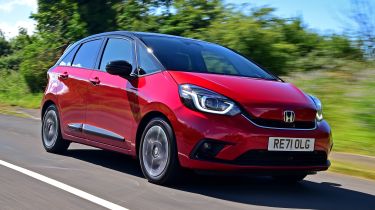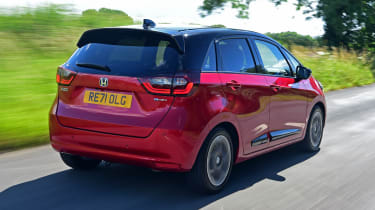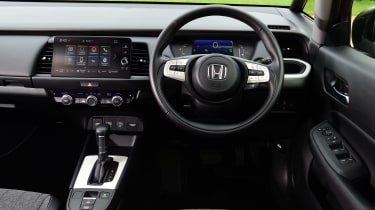New Honda Jazz EX Style 2022 review
The Honda Jazz is a spacious and efficient supermini, but does it make the most sense in top-spec EX Style trim? We find out...

Verdict
The EX Style maintains the typical Jazz plus points of a fabulously spacious cabin and brilliant fuel economy. The hybrid system is very slick, and the ride and handling are more than up to the job. However, we can’t help but feel that this range-topper doesn’t really add enough to warrant the extra cost over the already generously equipped models further down the range.
This is the Honda Jazz EX Style - the range-topping version of one of the most spacious superminis money can buy. When many would see space as something of a luxurious virtue in itself, does this posh trim represent a perfect match for the Jazz?
As you’d expect, the kit levels are excellent. From the outside, it’s distinguished from other models in the range thanks to a unique set of 16-inch alloy wheels. There’s also a contrasting black roof plus door mirrors - seemingly a must-have accessory for any highly specced hatchback these days - and an extended rear spoiler.
Inside, the Jazz is equally well furnished. The seats are trimmed in a part-cloth/part-leather upholstery, while those in the front are heated - as is the steering wheel. The fabrics feel suitably smart, and the responsive touchscreen is backed up by a digital instrument panel. While it feels solidly put together, it doesn’t look or feel as special inside as the Skoda Fabia or the Renault Clio.
Used - available now
The trim level may have introduced some fancy tech, but the undisputed big Jazz selling point is its practicality. It starts up front, where there are no less than nine separate storage spaces for the driver and passenger. Three of them are cup holders. There’s also a pair of glove boxes, which offer plenty of secure storage, and the door bins are a great size, too. Our only minor gripe is that we’d prefer a slightly deeper smartphone shelf; if it was angled down more steeply as in cars like the Fabia, it would hold a device more securely.
Meanwhile, there’s a huge amount of space in the back seats. Even though the Honda shorter its Skoda rival, the taller roofline and short bonnet work wonders for packaging, with rear knee room one clear area where the Jazz excels. The centre seat is very much designed to be a temporary position though; the base is narrow, perched and rounded, which means that, unlike the outer seats, it’s not very comfortable to sit on.
Honda’s ‘Magic Seats’ help the usability too. Not only can the seat squabs fold up against the backrests to give a very tall storage space in the middle of the car, but a clever hinge means that, when the backrests are folded, the squabs drop forward into the footwell, allowing for a completely level and low storage area. Seats up, the 304-litre boot is okay in terms of volume, but not class-leading. Cargo net hooks are another extra beyond the standard EX trim.
In everyday driving, the Honda’s hybrid system is one of the most seamless on the market. Never mind supermini rivals like the Renault Clio E-Tech and Toyota Yaris - the transition between petrol and electric drive is pretty much the smoothest you’ll find in any hybrid on sale. The electric motor has plenty of punch away from the line, so even in the short bursts of electric-only driving, the performance is lively.
The only downside is that the engine can sound a little intrusive when accelerating hard for a sustained period - say when accelerating onto a motorway or performing an overtake. While the eCVT gearbox artificially steps the engine speed to give an impression of a conventional gearbox, there’s still an unpleasant flare of revs when you demand all the power on offer. In this area, its hybrid rivals from Toyota and particularly Renault have an edge.
Like those hybrid rivals, some unpleasant noises can be easily forgiven when the fuel returns are so impressive. The Jazz is keen to make the most of the zero-emission side of its powertrain, and with the combustion element only kicking in when it’s really needed, the benefits are clear at the pumps. Our time driving on a wide mix of roads, both short and long journeys, resulted in average fuel consumption of 65.8mpg. At a time when fuel prices are higher than ever before, never has such a strong result been so appealing.
The rest of the Jazz driving experience is fine. It goes around corners without any drama, grip is okay, and the steering is well-weighted. Ride comfort on those 16-inch wheels is above average for the class, and overall refinement is fine.
While there’s plenty to like about this Jazz, the downside is the price. The EX Style is priced at £26,410 - that’s an increase of £2,395 over the regular EX model, which for some contrasting roof paint and little else doesn’t really seem like great value for money to us.
Place a £2,500 deposit on a three-year PCP agreement with a 10,000-mile annual limit, and the total figure comes to £419 per month. On matching terms, the standard EX model costs £354 per month.
| Model: | Honda Jazz EX Style |
| Price: | £26,410 |
| Engine: | 1.5 4cyl petrol hybrid |
| Power: | 96bhp/253Nm |
| Transmission: | eCVT, front-wheel drive |
| 0-62mph: | 9.4 seconds |
| Top speed: | 109 mph |
| Economy/CO2: | 62.8mpg/102g/km |
| On sale: | Now |















